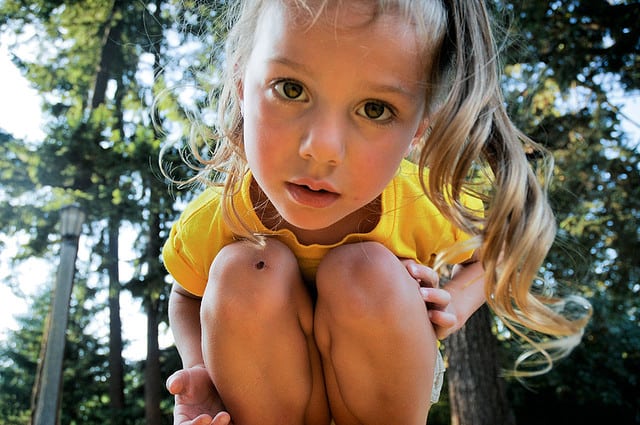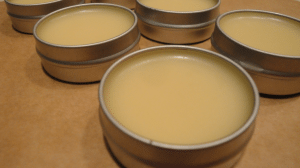Photo by Jessie Millian
Children love playing outside running around in the yard or even just laying in the grass. Outside play is so important for their development and brings nature into their everyday life. Cuts and scrapes are inevitable for toddlers and younger children. Toddlers are still a little unsteady on their feet and younger children are just getting brave enough to try new things that may cause a spill. Treating a cut or scrape naturally is just as easy as treating it the conventional way. It’s really just a matter of stocking your first aid kit with natural options.
Why Conventional Treatments Aren’t Ideal
Common conventional first aid options include antibiotic creams and petroleum based products. The widespread use of antibiotic creams and washes lead to resistant bacteria such as MSRA. Cuts can safely be treated with natural alternatives that won’t have these long term effects on our population. Read more about the dangers of anti-bacterial products in my other post, Hand Sanitizers: Good or Bad? Petroleum based products are not a good choice for our environment and also have negative health effects. Petroleum creates a barrier on the skin and blocks pores from breathing. It has also been said that it could be carcinogenic.
These conventional first aid creams are not any more effective then their natural alternatives. In my experience the natural remedies have worked better then things I have used in the past before I knew anything about holistic health and all natural alternatives. Just recently, my daughter had a scrape on her knee that started looking a little red and puffy. We continuously applied one of my homemade ointments and it cleared up quickly.
Effective Natural Treatments
With any cut or scrape the first thing to do is to simply clean the area with plain soap and water. Once the area is clean you can treat with a natural ointment or other remedy and cover with a bandage. These are my go to options for natural treatments:
- Homemade Tea Tree Oil Ointment (recipe below) – Tea tree oil is a natural antiseptic and antimicrobial. This is my number one go to choice for minor wounds. It is very easy to apply and it can be kept with you in a small tin for playground emergencies.
- Manuka Honey – This is some amazing stuff. It can be used on cuts, scrapes, and bug bites. Raw Manuka Honey
has been said to clear MSRA infections. It is a very safe alternative to antibacterial creams that is more effective.
- Homemade GSE Boo Boo Spray – This is another very easy thing to make and use. This is great to use if you don’t have a bandage or if your child doesn’t want to wear one. It can be easily spritzed onto the wound a multiple times a day. Fill a spray bottle with water and add a few drops of Grapefruit Seed Extract (GSE) and Tea Tree Oil or Lavender Oil.
How to Make Your Own Ointment
Making your own ointment is very easy and inexpensive. The added benefit of making your own is that you know exactly what is in it and you know it is safe to use on your children.
Ingredients:
- 1/4 cup Coconut Oil
- 1/4 cup liquid oil (meaning it doesn’t solidify) like olive oil, grapeseed oil, macadamia nut oil, sweet almond oil, etc.
- 2 tbsp. shaved beeswax
- 10 drops tea tree oil (The best essential oils I have used are from Young Living)
What are your go to natural treatments for cuts and scrapes? Have you tried any of the things I’ve mentioned before?




Salve made with plantain, jewelweed, and comfrey! Immediate relief from bug bites and minor wounds and it helps it heal so quickly!
I like using honey – local, raw, unfiltered. It’s not Manuka (which can cost an arm and a leg!) but it works really well for me. My other “go to” is homemade calendula-infused coconut oil. I keep mine in a pint mason jar and use it as a slave right out of the jar. One other that works wonderfully for cuts (especially in the kitchen) is turmeric – I sprinkle powdered turmeric directly on the cut and sort of rub it in, or apply a turmeric paste. It stops the bleeding almost right away, reduces the pain, and I noticed the cuts heal up much quicker, even without a bandage (hard to keep on fingers when working in the kitchen).
While I did not have the Manuka Honey, I did use raw honey on a possible MRSA infection and it did go away with out going to the hospital as I had with a previous MRSA. I got the second just 3 months after the first and the hospital treated me with the strongest IV antibiotic out there. After treating the second potential MRSA with raw honey and cleaning it with peroxide I have been 5 yrs without another problem. I think this speaks to the healing power of the honey and not the conventional treatment. I use raw honey all the time on cuts for my kids. Just last week my 9 yr old cut her finger on Wed. we treated it with honey and by Sat evening it was completely healed.
Yay! I’m going to make the spray and ointment – I already have everything to make them in my supplies!
I got a “need stitches” kind of cut on my knuckle from a glass jar. I had read that cayenne is one of the best emergency herbs so I had my husband dump it on (I was too light headed to do it myself). It was warm but didn’t burn and it stopped the bleeding almost immediately! I put raw honey (from our own bees) on it over the cayenne, wrapped it, and splinted it. In two days, I took the bandage off and was shocked to see that it was sealed closed and almost healed! I have no scar now and never got stitches! (I’m not recommending this, just saying it worked for me! =) )
Does tea tree oil hurt on an open wound? About two weeks ago my son tore a huge flap from the top of his toe while riding a bike. It was red and raw and had dirt in it. I wanted to use tea tree, but was afraid it would burn. I ended up using Neosporin because I was unsure what else to do. Luckily, its healed now, but I’d like to k.ow for next time. Thanks!
I like to use Bulk Herb Store’s Eden Salve, or Mexican Wildflower’s Healing Garden Salve. They both take the bite out of the bug-bites I always tend to be companion to. I’ve not tired your three ideas. I have made my own soothing hand creams before, with coconut oil, a couple gentle herbs, and some beeswax.
Thanks for the spray recipe! I have 3 little boys that will need this all the time!
Hi ladies, I have never used straight tea tree oil on an open cut…but in the ointments it does not burn. Hope that helps!
Thank you for this post! Just last week my daughter scraped up both knees really badly and I thought about putting some traditional ointment on them. I usually wouldn’t but the were really bad. I am so glad I didn’t. Just today I got to use some knowledge gained from this post for my nephew’s foot.
I’m trying to think of another way to store the ointment. I have everything needed to make it! And where would you get grapefruit seed extract? Is that something I could make like other extracts?!?
This is definitely good information to have…my little ones seem to always be getting scraped up somehow!
I left a comment on the MAH FB wall.
This is some good stuff but it’s not sold in the US. It can be ordered from the UK and while the brand (Weleda) is sold here, this specific product is NOT. But its ingredients (hypericum and calendula) are very healing to the tissues and I use it on scrapes and any sore diaper rashes. http://www.skylarkbooks.co.uk/Shop/media/Weleda-Hypericum-Calendula-Ointment.htm We also use straight coconut oil but your recipe above for a go to ointment looks good.
I am new to the idea of alternative health and at this point we are beginners, just working on eating better, avoiding preservatives and artifical junk, not using plastic in the microwave, etc. Not sure how far we’ll get, so I thought about and researched this… honestly I am a little bit shell shocked. Not sure how making my own ointment is considered “inexpensive”, It would cost over $40 to buy the stuff to make my own. $26 for honey? Inexpensive compared to what? A tube of generic antibiotic ointment lasts us at least a year and costs $2 (unless I get freebies from work or the pediatrician). We use ointment so infrequently I am thinking that a dab of antibiotic and petroleum jelly on occasion is less of a stressor for us that the cost of the natural remedies!
I am looking for natural alternatives to heal a large ulcer on my ankle that became infected with Ecolli, the ankle is swollen and the wound continues to increase in size and isn’t healing well. I’m looking for alternatives for healing ointments to heal the wound and keep it moist as It is extremely painful when it’s dry. My Doctor hasn’t been able to help much using conventional treatments. It’s difficult to walk on and I’m very concerned, I have been looking at the different ointments that can be made and was wondering if anyone has any ideas ingredients would help to heal a very large scabbed over wound. Thank you for your time.
Hello,
I have a question. I just recently found out I am pregnant. (6 weeks). I went to get a pedicure the other day and and realized there is fungus underneath of my big toes. I read that tea tree oil is great for that. I am also reading mixed reviews that tea tree oil should not be taken when pregnant? Can you tell me your views on this??